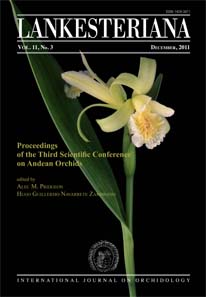Preliminary molecular phylogenetics of Sobralia and relatives (Orchidaceae: Sobralieae)
DOI:
https://doi.org/10.15517/lank.v11i3.18286Keywords:
Orchidaceae, Sobralieae, Sobralia, phylogeneticsAbstract
With over 200 species, the orchid tribe Sobralieae is a major constituent of the Neotropical flora. As currently circumscribed, the tribe includes four genera: Elleanthus, Epilyna, Sertifera, and Sobralia. Most species of these four genera typically produce long, cane-like stems but differ drastically in flower size and inflorescence structure. DNA sequence data support the monophyly of Elleanthus, Epilyna, and Sertifera but not Sobralia, which is a polyphyletic assemblage traditionally placed together due to relatively large flower size. Details of inflorescence structure provide characters that can easily distinguish the different clades of Sobralia. The misleading characteristic of flower size is probably due to at least several shifts in pollination syndrome within the tribe. With few exceptions, species of Sobralia predominantly offer no reward and are pollinated by bees. Elleanthus and Sertifera are small-flowered and mostly pollinated by hummingbirds with legitimate rewards. Nothing is known of pollination in Epilyna. Understanding the evolution of shifts in pollination syndrome will require more empirical observations of pollination within Sobralieae. In addition, increased taxon sampling and improved phylogenetic resolution are needed before generic realignments are made.
Downloads
Downloads
Published
How to Cite
Issue
Section
License
According to the Open Access policy promoted by the University of Costa Rica, all the papers published by Lankesteriana are licensed under the Creative Commons copyright and can be downloaded free of charge. The journal holds copyright and publishing rights under the CC BY-NC-ND 3.0 CR license.
Before the publication of the materials submitted by the author(s) in LANKESTERIANA, the author(s) hereby assign all rights in the article to the Lankester Botanical Garden.





